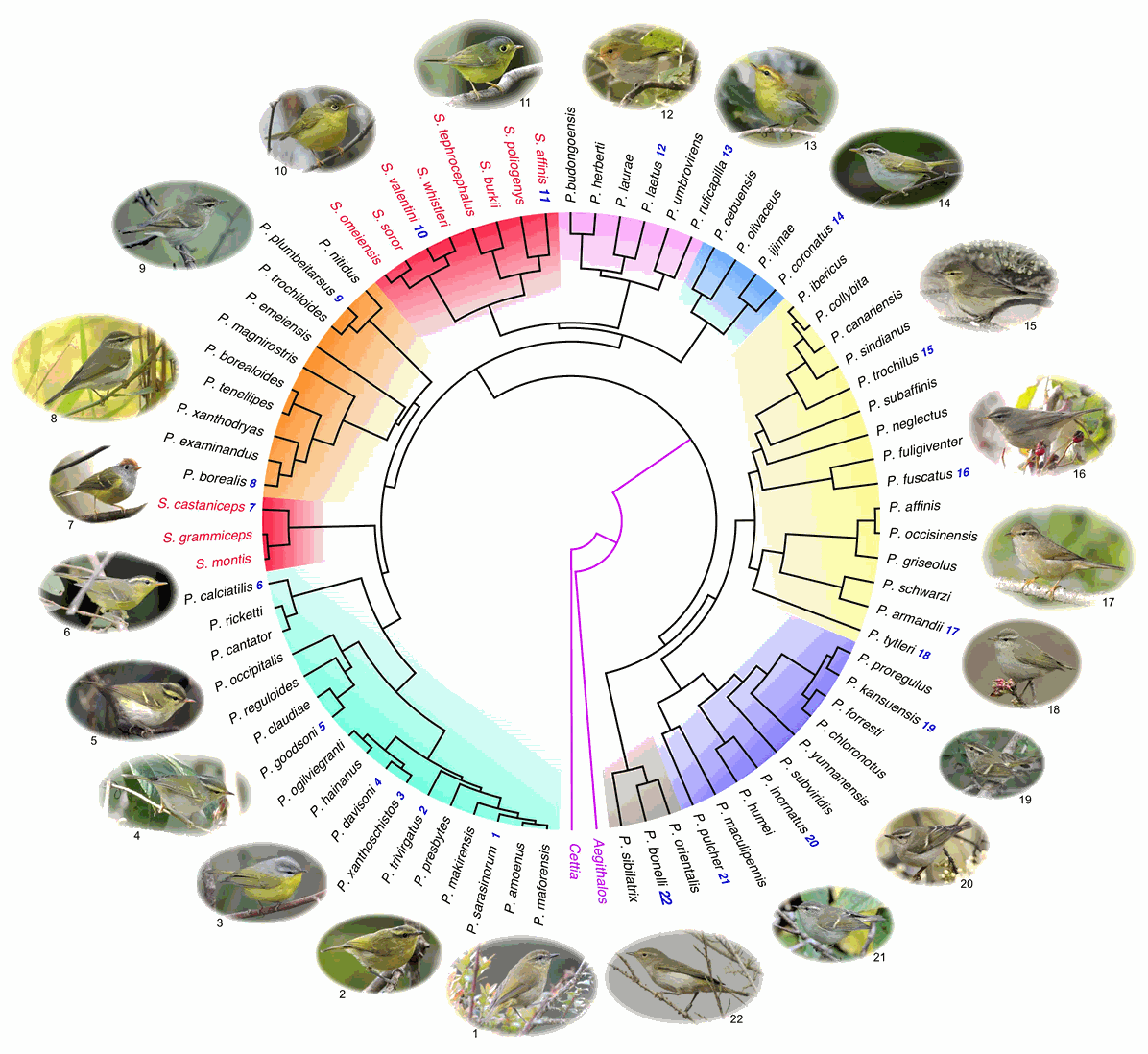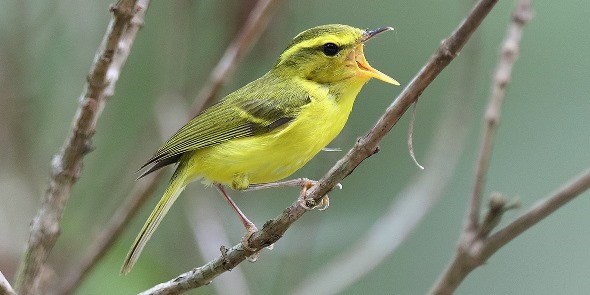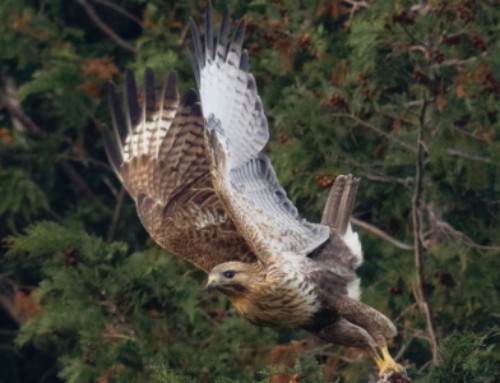LINKED PAPER
Complete species-level phylogeny of the leaf warbler (Aves: Phylloscopidae) radiation. Alström, P., Rheindt, F.E., Zhang, R., Zhao, M., Wang, J., Zhu, X., Gwee, C.Y., Hao, Y., Ohlson, J., Jia, C., Prawiradilaga, D.M., Ericson, P.G.P., Lei, F. & Olsson, U. 2018. Molecular Phylogenetics and Evolution. DOI: 10.1016/j.ympev.2018.03.031. VIEW
Old World leaf warblers (family Phylloscopidae) are small insectivorous birds, which are renowned for often being difficult to identify by appearance but more easily distinguishable by song (Ticehurst 1938, Bairlein et al. 2006). They are distributed throughout much of the Old World, with the highest number occurring in Asia.
The taxonomy of leaf warblers has undergone dramatic change in the past three decades, with the number of recognised species rising from 52 in the mid-1980s (Watson et al. 1986) to 77–78 at present (Dickinson & Christidis 2014, del Hoyo & Collar 2016, Gill & Donsker 2017). This increase is mainly the result of studies of vocalisations and DNA, which have elevated multiple subspecies to species rank, but no fewer than six new species have also been described in this period (Martens 2010, Alström et al. 2013).
Several papers have analysed mitochondrial DNA (mtDNA) or a combination of mtDNA and a few nuclear DNA markers for various sets of leaf warblers (see reviews by Martens 2010 and Alström et al. 2013). Based on these studies, different authors have proposed different classifications, either recognising multiple genera (Dickinson & Christidis 2014, Boyd 2017) or synonymising Seicercus with Phylloscopus (del Hoyo & Collar 2016).
Complete species-level phylogeny
In a recent paper, we analysed a multilocus dataset for all currently recognised species in the family Phylloscopidae to infer the phylogeny and estimate divergence times. The tree (Fig 1) identifies several well supported clades. The genus Seicercus is found in two clades (F, M) that are well separated in the tree – i.e. both Seicercus and Phylloscopus are non-monophyletic.

The most recent common ancestor for the family is dated at 11.7 million years ago (mya) (95% highest posterior density 9.8–13.7 mya). Divergence times between sister species vary from 0.5 mya (0.3–0.8 mya; Sunda Warbler S. grammiceps – Yellow-breasted Warbler S. montis) to 6.1 mya (4.8–7.5 mya; Buff-barred Warbler P. pulcher – Ashy-throated Warbler P. maculipennis).
Several groups of closely related species, some of which have disputed taxonomy, originated less than 2.5 mya, e.g. the Pallas’s Leaf Warbler P. proregulus (clade V), Chiffchaff P. collybita (Q), Greenish Warbler P. trochiloides (J) and Arctic Warbler P. borealis (H) complexes, as well as the entire Sundaland–Melanesia radiation (A1).
Morphological evolution
Although not the focus of this paper, a few comments can be made on the morphological evolution.
- Most of the main clades have evolved a novel “basic plumage type” (most striking for clades F and M), which has usually been highly conserved with only slight modifications over long time spans. For example, the Arctic Warbler complex (clade H) and Greenish Warbler complex (J) are difficult to distinguish by appearance despite c. 7.5 my of independent evolution.
- The rate of plumage divergence has been overall higher in some of the main clades, especially in the Philippine-Sundaland-Melanesian radiation (clade A1), where the six species (divided into c. 35 subspecies) share a most recent common ancestor < 2.5 mya.
- In clade A2, two of the species (Davison’s Leaf Warbler P. davisoni, Kloss’s Leaf Warbler P. ogilviegranti) appear to have retained an ancestral plumage type shared with the species in clade B, whereas the two other species (Grey-hooded Warbler P. xanthoschistos, Hainan Leaf Warbler P. hainanus) have diverged strongly in plumage, the former so much that it was previously placed in the traditional genus Seicercus.
- There are several cases of convergent plumage evolution. For example, striped crown, pale wingbars and bright yellow underparts appear to have evolved independently multiple times; e.g., P. coronatus and especially P. emeiensis are very similar to the species in clade B and to two of the species in clade A2.
Taxonomic implications
Based on our results, we support synonymising Seicercus with Phylloscopus, which results in a monogeneric Phylloscopidae. We discuss the pros and cons of this treatment, and we argue against proliferation of taxonomic names, and conclude that a large monogeneric Phylloscopidae leads to the fewest taxonomic changes compared to traditional classifications.
The recent divergence of Sunda and Yellow-breasted Warbler (see above) as well as the unexpected deep divergence within P. bonelli (cf. Fig. 1) call for further studies.
Finally, this phylogeny provides a basis for future studies of other aspects of phylloscopid evolution.
References
Alström, P., Olsson, U. & Lei, F. 2013. A review of the recent advances in the systematics of the avian superfamily Sylvioidea. Chinese Birds 4: 99–131. VIEW
Bairlein, F., Alström, P., Aymí, R., Clement, P., Dyrcz, A., Gargallo, G., Hawkins, F., Madge, S., Pearson, D. & Svensson, L. 2006. Family Sylviidae (Warblers). In: del Hoyo, J., Elliott, A., Christie, D.A. (Eds.), Handbook of the Birds of the World, Volume 12. Lynx Edicions, Barcelona, pp. 492–709.
Boyd, J.H. 2017. Taxonomy in Flux Checklist 3.08. VIEW
del Hoyo, J. & Collar, N.J. 2016. HBW and BirdLife International Illustrated Checklist of the Birds of the World. Volume 2: Passerines. Lynx Edicions, Barcelona.
Dickinson, E.C. & Christidis, L. 2014. The Howard & Moore Complete Checklist of the Birds of the World, 4th ed., Vol. 2. Aves Press, Eastbourne, U.K.
Gill, F. & Donsker, D. 2017. IOC World Bird List (v. 7.2). DOI: 10.14344/IOC.ML.7.2. VIEW
Martens, J. 2010. A preliminary review of the leaf warbler genera Phylloscopus and Seicercus. Br. Ornithol. Club Occasional Publ. 5: 41–116. VIEW
Ticehurst, C.B. 1938. A Systematic review of the Genus Phylloscopus (Willow-Warblers or Leaf-Warblers). Trustees of the British Museum, London.
Watson, G.E., Traylor. M.A., Jr. Mayr. E. 1986. In: Mayr. E. & Cottrell, G.W. (Eds) Check-list of Birds of the World. Vol. 11. Museum of Comparative Zoology, Cambridge, Massachusetts.
Image credits
Featured image: Hainan Leaf Warbler Phylloscopus hainanus, Hainan, China 12 April 2017 © Jonathan Martinez
Fig. 1: Craig Brelsford (14), James Eaton (2, 10, 18, 19), Göran Ekström (9, 15, 16, 22), Jocko Hammar (6), Jonathan Martinez (5, 7, 8, 11, 20), Yann Muzika (1), Frédéric Pelsy (12), Megan & Chris Perkins (3), Nick Robinson (4, 13, 17, 21).




